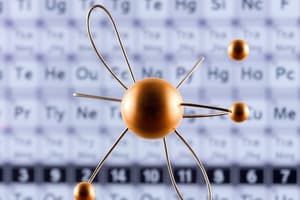Podcast
Questions and Answers
下列元素中,哪一种元素的金属性最强?
下列元素中,哪一种元素的金属性最强?
- 铍
- 锂 (correct)
- 硼
- 碳
卤素的反应活性从上到下递减。
卤素的反应活性从上到下递减。
True (A)
钠与氯气反应生成的化学方程式是什么?
钠与氯气反应生成的化学方程式是什么?
2Na + Cl₂ = 2NaCl
元素周期表中,同一主族的元素具有相似的 __________ 及特性。
元素周期表中,同一主族的元素具有相似的 __________ 及特性。
匹配下列元素及其对应的性质:
匹配下列元素及其对应的性质:
下列哪个选项正确描述了周期表中的金属和非金属元素?
下列哪个选项正确描述了周期表中的金属和非金属元素?
钾元素的原子序数为多少?
钾元素的原子序数为多少?
在元素周期表中, extbf{_____}的反应活性随原子半径增大而增加。
在元素周期表中, extbf{_____}的反应活性随原子半径增大而增加。
将元素与其属性匹配:
将元素与其属性匹配:
Flashcards
同一周期元素的金属性递变规律
同一周期元素的金属性递变规律
同一周期从左到右,金属性逐渐减弱。
同一主族元素的金属性递变规律
同一主族元素的金属性递变规律
同一主族从上到下,金属性逐渐增强。
卤素的反应活性规律
卤素的反应活性规律
卤素的反应活性从上到下逐渐减弱。
钠与氯气反应的化学方程式
钠与氯气反应的化学方程式
Signup and view all the flashcards
元素周期表中同一周期的元素
元素周期表中同一周期的元素
Signup and view all the flashcards
元素周期表结构
元素周期表结构
Signup and view all the flashcards
原子序数
原子序数
Signup and view all the flashcards
金属性
金属性
Signup and view all the flashcards
非金属性
非金属性
Signup and view all the flashcards
电子排布
电子排布
Signup and view all the flashcards
Study Notes
IGCSE Chemistry: Periodic Table
-
Pre-Learning Notes: A comprehensive understanding of the periodic table is crucial. Focus on key areas like structure, atomic structure, electron configuration, and periodic trends.
-
Knowledge Points:
- Basic knowledge: Periodic table structure (periods, groups, atomic number), atomic structure (protons, neutrons, electrons, relative atomic mass), electron configuration (electron shells, outermost electrons).
- Key Concepts: Atomic structure and electron configuration affect chemical properties. Understanding trends in metallic and non-metallic properties.
- Difficult Concepts: Predicting element properties and chemical reactions from the periodic table and explaining these shifts.
-
Example Questions:
- Atomic Number: Determine the atomic number of sulfur, given its position on the periodic table.
- Electron Configuration: Describe the electron configuration of potassium and its classification as a metal or nonmetal.
- Relative Atomic Mass: Calculate the relative atomic mass of boron given its isotopes' abundances.
Classroom Notes
-
Periodic Table Structure: Columns (groups) and rows (periods) form the periodic table. Periods have similar electron shell numbers.
-
Atomic Structure: Atoms have protons, neutrons, and electrons. The number of protons (atomic number) uniquely identifies an element.
-
Electron Configuration: Electrons fill electron shells according to energy levels. Outermost electrons (valence electrons) are key to chemical properties.
-
Metallic and Non-Metallic Properties: Elements are grouped by trends. Across a period, metallic character decreases and non-metallic character increases. Down a group, metallic character increases and non-metallic character decreases.
-
Specific Groups:
- Halogens: Nonmetals with decreasing reactivity down the group. Reactivity decreases with increasing atomic radius (distance from nucleus to electrons).
- Alkali Metals: Very reactive metals with increasing reactivity down the group. Reactivity increases with increasing atomic radius.
- Transition Metals: Grouped in the middle of the table, have variable oxidation states. Often show complex behavior.
-
Predicting Element Properties from the Periodic Table: Knowing an element's position allows prediction of its properties such as metallic/non-metallic character and reactivity. Similarly, predicting chemical reactions is also possible by understanding elements' positions and properties.
Review/Preparation
-
Mind Map: Create a visual map connecting key concepts like the table structure and trends (metallic/non-metallic, reactivity).
-
Summary of Key Areas:
- Key Concepts: Periodic trends, properties of specific groups.
- Challenging Concepts: Predicting properties and reactions. Understanding the trends behind properties.
- Potential Errors: Confusion between trends in different groups and periods. Lack of comprehensive understanding of group properties (halogens, alkali metals).
-
Example Questions:
- Element Properties: Identify the element with the strongest metallic properties.
- Predicting Reactions: Write the balanced equation for the reaction of sodium with chlorine.
- Halogens: Illustrate the differences in properties of halogens down the group.
- Alkali Metals: What are the key characteristics that differentiate alkali metals?
- Understanding the Properties: Describe the properties and reactions of transition metals and their complexity.
- Predict Properties and Reactions: Using the table to predict the highest melting point among a set of elements.
- **Calculations:**Calculate the number of neutrons for given atoms or isotopes.
-
Study Tips: Deep understanding of concepts through examples and practice is crucial. Use practice problems to solidify knowledge. Keep a log of mistakes for future reference.
Studying That Suits You
Use AI to generate personalized quizzes and flashcards to suit your learning preferences.




